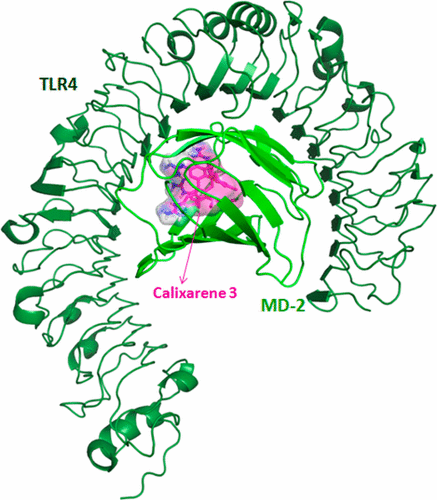当前位置:
X-MOL 学术
›
J. Med. Chem.
›
论文详情
Our official English website, www.x-mol.net, welcomes your
feedback! (Note: you will need to create a separate account there.)
Amphiphilic Guanidinocalixarenes Inhibit Lipopolysaccharide (LPS)- and Lectin-Stimulated Toll-like Receptor 4 (TLR4) Signaling
Journal of Medicinal Chemistry ( IF 6.8 ) Pub Date : 2017-05-04 00:00:00 , DOI: 10.1021/acs.jmedchem.7b00095 Stefania E. Sestito 1 , Fabio A. Facchini 1 , Ilaria Morbioli 2 , Jean-Marc Billod 3 , Sonsoles Martin-Santamaria 3 , Alessandro Casnati 2 , Francesco Sansone 2 , Francesco Peri 1
Journal of Medicinal Chemistry ( IF 6.8 ) Pub Date : 2017-05-04 00:00:00 , DOI: 10.1021/acs.jmedchem.7b00095 Stefania E. Sestito 1 , Fabio A. Facchini 1 , Ilaria Morbioli 2 , Jean-Marc Billod 3 , Sonsoles Martin-Santamaria 3 , Alessandro Casnati 2 , Francesco Sansone 2 , Francesco Peri 1
Affiliation

|
We recently reported on the activity of cationic amphiphiles in inhibiting TLR4 activation and subsequent production of inflammatory cytokines in cells and in animal models. Starting from the assumption that opportunely designed cationic amphiphiles can behave as CD14/MD-2 ligands and therefore modulate the TLR4 signaling, we present here a panel of amphiphilic guanidinocalixarenes whose structure was computationally optimized to dock into MD-2 and CD14 binding sites. Some of these calixarenes were active in inhibiting, in a dose-dependent way, the LPS-stimulated TLR4 activation and TLR4-dependent cytokine production in human and mouse cells. Moreover, guanidinocalixarenes also inhibited TLR4 signaling when TLR4 was activated by a non-LPS stimulus, the plant lectin PHA. While the activity of guanidinocalixarenes in inhibiting LPS toxic action has previously been related to their capacity to bind LPS, we suggest a direct antagonist effect of calixarenes on TLR4/MD-2 dimerization, pointing at the calixarene moiety as a potential scaffold for the development of new TLR4-directed therapeutics.
中文翻译:

两亲胍基杯芳烃抑制脂多糖(LPS)和凝集素刺激的Toll样受体4(TLR4)信号传导。
我们最近报道了阳离子两亲物在抑制TLR4活化以及随后在细胞和动物模型中产生炎性细胞因子的活性。从适当设计的阳离子两亲物可以充当CD14 / MD-2配体并因此调节TLR4信号的假设出发,我们在此介绍一组两亲性胍基杯芳烃,其结构在计算上经过优化,可与MD-2和CD14结合位点对接。这些杯芳烃中的一些在以剂量依赖性方式抑制人和小鼠细胞中LPS刺激的TLR4活化和TLR4依赖性细胞因子产生方面具有活性。此外,当TLR4被非LPS刺激(植物凝集素PHA)激活时,胍基杯芳烃也抑制TLR4信号传导。
更新日期:2017-05-16
中文翻译:

两亲胍基杯芳烃抑制脂多糖(LPS)和凝集素刺激的Toll样受体4(TLR4)信号传导。
我们最近报道了阳离子两亲物在抑制TLR4活化以及随后在细胞和动物模型中产生炎性细胞因子的活性。从适当设计的阳离子两亲物可以充当CD14 / MD-2配体并因此调节TLR4信号的假设出发,我们在此介绍一组两亲性胍基杯芳烃,其结构在计算上经过优化,可与MD-2和CD14结合位点对接。这些杯芳烃中的一些在以剂量依赖性方式抑制人和小鼠细胞中LPS刺激的TLR4活化和TLR4依赖性细胞因子产生方面具有活性。此外,当TLR4被非LPS刺激(植物凝集素PHA)激活时,胍基杯芳烃也抑制TLR4信号传导。











































 京公网安备 11010802027423号
京公网安备 11010802027423号